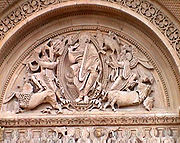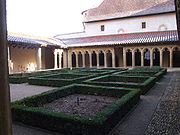
Charlieu Abbey
Encyclopedia

Charlieu
Charlieu is a commune in the Loire department at the northern end of the Rhône-Alpes region of France. It is home to Charlieu Abbey.-External links:* *...
, Loire, Burgundy
Bourgogne
Burgundy is one of the 27 regions of France.The name comes from the Burgundians, an ancient Germanic people who settled in the area in early Middle-age. The region of Burgundy is both larger than the old Duchy of Burgundy and smaller than the area ruled by the Dukes of Burgundy, from the modern...
, France
France
The French Republic , The French Republic , The French Republic , (commonly known as France , is a unitary semi-presidential republic in Western Europe with several overseas territories and islands located on other continents and in the Indian, Pacific, and Atlantic oceans. Metropolitan France...
, was a Benedictine abbey, and later a Cluniac priory.
History
The monastery, dedicated to Saint FortunatusSaint Fortunatus
Saint Fortunatus may refer to:*Venantius Fortunatus , Roman Catholic bishop and saint*Fortunatus of Casei *Fortunatus , martyr*Fortunatus of Todi , bishop of Todi*Fortunatus of Spoleto , priest near Montefalco...
, was founded in 872, in this region of southern Burgundy known as the Forez
Forez
Forez is a former province of France, corresponding approximately to the central part of the modern Loire département and a part of the Haute-Loire and Puy-de-Dôme départements....
. Its patrons were Ratbertus, bishop of Valence, and his brother Edward, in a place they called Carus Locus ("dear place"), and dedicated to Saint Stephen
Saint Stephen
Saint Stephen The Protomartyr , the protomartyr of Christianity, is venerated as a saint in the Roman Catholic, Anglican, Lutheran, Oriental Orthodox and Eastern Orthodox Churches....
and Saint Fortunatus, patron of Valence, with his co-martyrs Felix and Achilles. The abbey was placed under the direct control of the Holy See
Holy See
The Holy See is the episcopal jurisdiction of the Catholic Church in Rome, in which its Bishop is commonly known as the Pope. It is the preeminent episcopal see of the Catholic Church, forming the central government of the Church. As such, diplomatically, and in other spheres the Holy See acts and...
.
The tradition that the abbey church and other structures at the site were erected by Gausmar, the first abbot, and his monks with their own hands is belied by the fine and professional character of the masonry uncovered when remains of the foundations of the Carolingian
Carolingian
The Carolingian dynasty was a Frankish noble family with origins in the Arnulfing and Pippinid clans of the 7th century AD. The name "Carolingian", Medieval Latin karolingi, an altered form of an unattested Old High German *karling, kerling The Carolingian dynasty (known variously as the...
abbey were uncovered at the site in 1927. Its roof was wooden, for no foundations for interior supporting piers were found. Pencil towers no more than two meters in diameter encircled the corners of its façade and its apsidal
Apse
In architecture, the apse is a semicircular recess covered with a hemispherical vault or semi-dome...
east end, which had a semi-subterranean ambulatory
Ambulatory
The ambulatory is the covered passage around a cloister. The term is sometimes applied to the procession way around the east end of a cathedral or large church and behind the high altar....
; semi-circular buttress
Buttress
A buttress is an architectural structure built against or projecting from a wall which serves to support or reinforce the wall...
es strengthened the walls at intervals.

Boso of Provence
Boso was a Frankish nobleman from the Bosonid-family, who was related to the Carolingian dynasty, who rose to become King of Provence ....
, who placed a priory in Charlieu's gift when he was crowned King of Provence (879); the abbey long claimed that Boso was buried at Charlieu. By 926 the abbey was important enough to be the seat of a synod
Synod
A synod historically is a council of a church, usually convened to decide an issue of doctrine, administration or application. In modern usage, the word often refers to the governing body of a particular church, whether its members are meeting or not...
, at which it was decided that certain alienated church properties were to be returned to the church by their lay proprietors.
The Benedictine community at Charlieu was annexed by the Cluniac movement
Cluniac Reforms
The Cluniac Reforms were a series of changes within medieval monasticism of West focused on restoring the traditional monastic life, encouraging art, and caring for the poor. The movement is named for the Abbey of Cluny in Burgundy, where it started within the Benedictine order. The reforms were...
in 932, one of Cluny's earliest acquisitions and always among the first mentioned in any list of Cluniac houses. In the eleventh century the abbot was reduced to a prior
Prior
Prior is an ecclesiastical title, derived from the Latin adjective for 'earlier, first', with several notable uses.-Monastic superiors:A Prior is a monastic superior, usually lower in rank than an Abbot. In the Rule of St...
. The church was rebuilt on a somewhat expanded plan under the rule of Odilo, abbot of Cluny
Saint Odilo of Cluny
-Biography:Odilo was born c. 962. He was descended from the nobility of Auvergne. He early became a cleric in the seminary of St. Julien in Brioude. In 991 he entered Cluny and before the end of his year of probation was made coadjutor to Abbot Mayeul....
, in the first half of the eleventh century, in a campaign that lasted fifty years, continuing under Odilo's successor Hugh
Hugh of Cluny
Hugh of Cluny was an Abbot of Cluny. He is sometimes referred to as "Hugh the Great" or "Hugh of Semur" and was canonized by the Roman Catholic Church as Saint Hugh . He was one of the most influential leaders of one of the most influential monastic orders of the Middle Ages.Abbot Hugh built the...
: the abbey church was consecrated in 1094. A narthex
Narthex
The narthex of a church is the entrance or lobby area, located at the end of the nave, at the far end from the church's main altar. Traditionally the narthex was a part of the church building, but was not considered part of the church proper...
was added in the twelfth century.
The community of Charlieu refused the Cluniac reforms of the seventeenth century, and on 19 March 1787, letters patent
Letters patent
Letters patent are a type of legal instrument in the form of a published written order issued by a monarch or president, generally granting an office, right, monopoly, title, or status to a person or corporation...
suppressed the abbey. On 9 September 1792 a Revolutionary mob
French Revolution
The French Revolution , sometimes distinguished as the 'Great French Revolution' , was a period of radical social and political upheaval in France and Europe. The absolute monarchy that had ruled France for centuries collapsed in three years...
broke into the abbey's muniments room and made a bonfire of all its records. In 1795 the abbey church was sold for the value of its building materials, in two lots, of which one, comprising the narthex and westernmost bay, still stand today as a ruin; the eastern end was razed.


